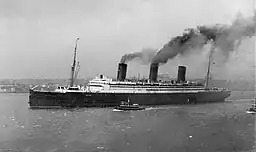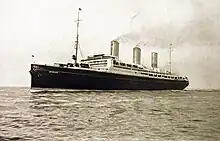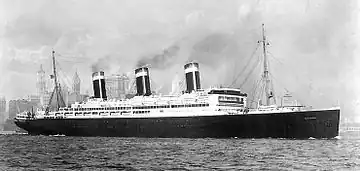Imperator-class ocean liner
The Imperator-class ocean liners were a series of three ocean liners designed for the Hamburg America Line, commonly known as HAPAG. These three ships were commissioned by the chairman of HAPAG Albert Ballin. Namely the Imperator (1912), the Vaterland (1913) and the largest, the Bismarck (1914). These liners were over 50,000 tons, sported three funnels and had a length ranging from 906 to 956 feet (276 to 291 m). Vaterland is the largest passenger ship ever operated by a German shipping company.
 The first Imperator-class liner, the Imperator | |
| Class overview | |
|---|---|
| Builders | AG Vulcan Stettin, Germany |
| Built | 1912–1914 |
| In service | 1913–1946 |
| Planned | 3 |
| Completed | 3 |
| Lost | 1 |
| Retired | 2 |
| General characteristics | |
| Type | Ocean liner |
| Tonnage | 52,117 - 56,551 GRT |
| Length | 906–956 ft (276–291 m) |
| Beam | 98 ft 3 in (29.9 m) to 100 ft 1 in (30.5 m) |
| Draught | 35 ft 2 in (10.7 m) to 37 ft 9 in (11.5 m) |
| Decks | 11 |
Background

The Hamburg America Line was one of two German shipping companies which operated transatlantic crossings, the other being North German Lloyd. The latter had had much success with the advent of their so-called Kaiser-class ocean liners, the first of which was the Kaiser Wilhelm der Grosse. Lloyd soon had a fleet of four liners with weekly transatlantic crossings on offer. By the turn of the century, HAPAG had only one flagship the Deutschland. Though successful, the Deutschland could not rival the "Four Flyers" owned by Lloyd. HAPAG soon added the Kaiserin Auguste Viktoria to their fleet which was the largest ship in the world at its launch in August 1906. British competition was also fierce, Cunard's Lusitania launched in 1906 followed by her sister Mauretania were an instant success and by 1910, the new Olympic-class ocean liners of White Star were nearing completion.
Ships
Imperator

Laid down on 18 June 1910, Imperator would be the largest ship in the world by the time it was completed in June 1913. The title of world's largest ship would be taken from White Star Line's RMS Olympic by a significant margin. Praised for having spacious interiors, Imperator would suffer from stability issues, as it had been discovered that her center of gravity was too high. A refit in October 1913 would attempt to resolve the issue by reducing the height of the funnels and replacing heavy furniture. Imperator's service to Germany would not last long as World War I saw her laid up at Hamburg. She remained inactive for the entirety of the war. After the Armistice of 11 November 1918, Imperator was seized by the U.S. and tasked with bringing American service personnel home from France.[1] Following her service as USS Imperator (ID-4080), she was transferred to the Cunard Line to replace the RMS Lusitania which sank in 1915. After a number of overhauls, Imperator was renamed after the English queen Berengaria of Naverre, in February 1921. Berengaria then became the flagship of the Cunard fleet, serving out a long career. After numerous electrical fires caused by aging wiring, Berengaria was set to be scrapped in 1938. She was completely demolished by 1946 due to the outbreak of World War II.
Vaterland

Being the second member of the Imperator-class, Vaterland significantly improved upon the design of her elder sister Imperator. Launched on 3 April 1913, she would take the title of world's largest ship when completed on 29 April 1914.

Bismarck
.png.webp)
Gallery
 USS Imperator (ID-4080), at left, and USS Leviathan (ID-1326) at Hoboken, New Jersey.
USS Imperator (ID-4080), at left, and USS Leviathan (ID-1326) at Hoboken, New Jersey. The SS Imperator of the Hamburg America Line after A.F. Bishop
The SS Imperator of the Hamburg America Line after A.F. Bishop R.M.S Majestic and R.M.S. Berengaria, Southampton 1922
R.M.S Majestic and R.M.S. Berengaria, Southampton 1922.jpg.webp) USS Leviathan being used to transport American troops, Brest, France, May 30, 1918
USS Leviathan being used to transport American troops, Brest, France, May 30, 1918 RMS Majestic being converted into HMS Caledonia
RMS Majestic being converted into HMS Caledonia
References
- Mark A. Russell: Steamship Nationalism: Ocean Liners and National Identity in Imperial Germany and the Atlantic World. Routledge Studies in Modern European History, Routledge New York, NY, 2020. ISBN 978-0-367-13643-7.
External links
 Media related to Imperator class ocean liners at Wikimedia Commons
Media related to Imperator class ocean liners at Wikimedia Commons- Imperator Class Liners-Germany's Big Three on YouTube
- "USS Imperator". Naval History and Heritage Command. Retrieved October 23, 2023.